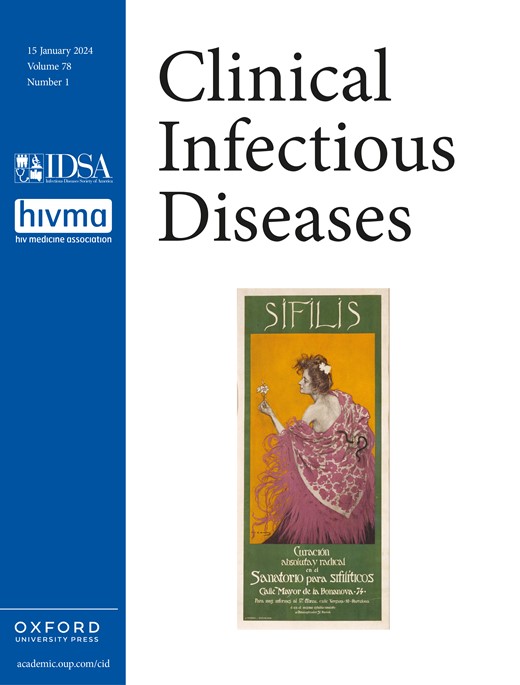肺结核患者的长期死亡率趋势:对巴西确诊肺结核患者的回顾性队列研究
IF 8.2
1区 医学
Q1 IMMUNOLOGY
引用次数: 0
摘要
背景:即使在成功治疗后,结核病存活者的死亡率也会升高。然而,关于这些风险如何随时间和个体特征而变化的证据有限。方法:我们对巴西诊断为结核病的个体进行了一项回顾性队列研究,使用2007-2016年的国家结核病通报和相关死亡率记录。与年龄、性别、年份和州匹配的一般人群死亡率相比,我们估计了自结核病诊断以来每年的死亡率比(MRRs)和累积死亡率。我们确定了与结核病后死亡率升高相关的临床和社会人口学因素,并比较了死亡原因与一般人群的分布。研究样本包括834,594人,随访410万人年(平均4.9年)。与一般人群相比,结核病队列的死亡率较高,特别是在诊断后的第一年(MRR 11.28, 95%CI: 11.18-11.37)。结核病后mrr从第2年的3.59(3.53-3.64)下降到第10年的1.46(1.34-1.59)。1年后累积超额死亡率为6.12%(6.07-6.17),10年后累积超额死亡率为9.90%(9.58-10.24)。在确诊时,30-44岁的人的核磁共振比最高。复发、随访失败以及艾滋病毒和酒精使用障碍等共同流行的疾病与较高的mrr密切相关。随着时间的推移,结核病队列中的主要死亡原因从结核病和艾滋病毒转变为心血管疾病、癌症和非结核病呼吸系统疾病。结论:结核病患者在诊断后10年内面临较高的死亡率。这些超额风险因人口统计学和临床特征而异。本文章由计算机程序翻译,如有差异,请以英文原文为准。
Long-term mortality trends among individuals with tuberculosis: a retrospective cohort study of individuals diagnosed with tuberculosis in Brazil
Background Even after successful treatment, individuals surviving tuberculosis (TB) disease experience elevated mortality rates. However, there is limited evidence on how these risks vary over time and by individual characteristics. Methods We conducted a retrospective cohort study of individuals diagnosed with TB in Brazil, using national TB notifications and linked mortality records for 2007-2016. We estimated mortality rate ratios (MRRs) and cumulative mortality by year since TB diagnosis, compared to general population mortality matched on age, sex, year, and state. We identified clinical and sociodemographic factors associated with elevated post-TB mortality, and compared the distribution of causes of death to the general population. Results The study sample included 834,594 individuals, with 4.1 million person-years of follow-up (average: 4.9 years). The TB cohort had elevated mortality compared to the general population, particularly in the first year post-diagnosis (MRR 11.28, 95%CI: 11.18–11.37). Post-TB MRRs declined from 3.59 (3.53–3.64) in year 2 to 1.46 (1.34–1.59) in year 10. Cumulative excess mortality was 6.12% (6.07–6.17) after 1 year and 9.90% (9.58–10.24) after 10 years. MRRs were highest for individuals 30-44 years-old at diagnosis. Relapse, loss to follow-up, and co-prevalent conditions like HIV and alcohol use disorder were strongly associated with higher MRRs. Over time, major causes of death in the TB cohort shifted from TB and HIV to cardiovascular disease, cancer, and non-TB respiratory diseases. Conclusions Individuals developing TB disease face elevated mortality up to 10 years after diagnosis. These excess risks vary across demographic and clinical characteristics.
求助全文
通过发布文献求助,成功后即可免费获取论文全文。
去求助
来源期刊

Clinical Infectious Diseases
医学-传染病学
CiteScore
25.00
自引率
2.50%
发文量
900
审稿时长
3 months
期刊介绍:
Clinical Infectious Diseases (CID) is dedicated to publishing original research, reviews, guidelines, and perspectives with the potential to reshape clinical practice, providing clinicians with valuable insights for patient care. CID comprehensively addresses the clinical presentation, diagnosis, treatment, and prevention of a wide spectrum of infectious diseases. The journal places a high priority on the assessment of current and innovative treatments, microbiology, immunology, and policies, ensuring relevance to patient care in its commitment to advancing the field of infectious diseases.
 求助内容:
求助内容: 应助结果提醒方式:
应助结果提醒方式:


